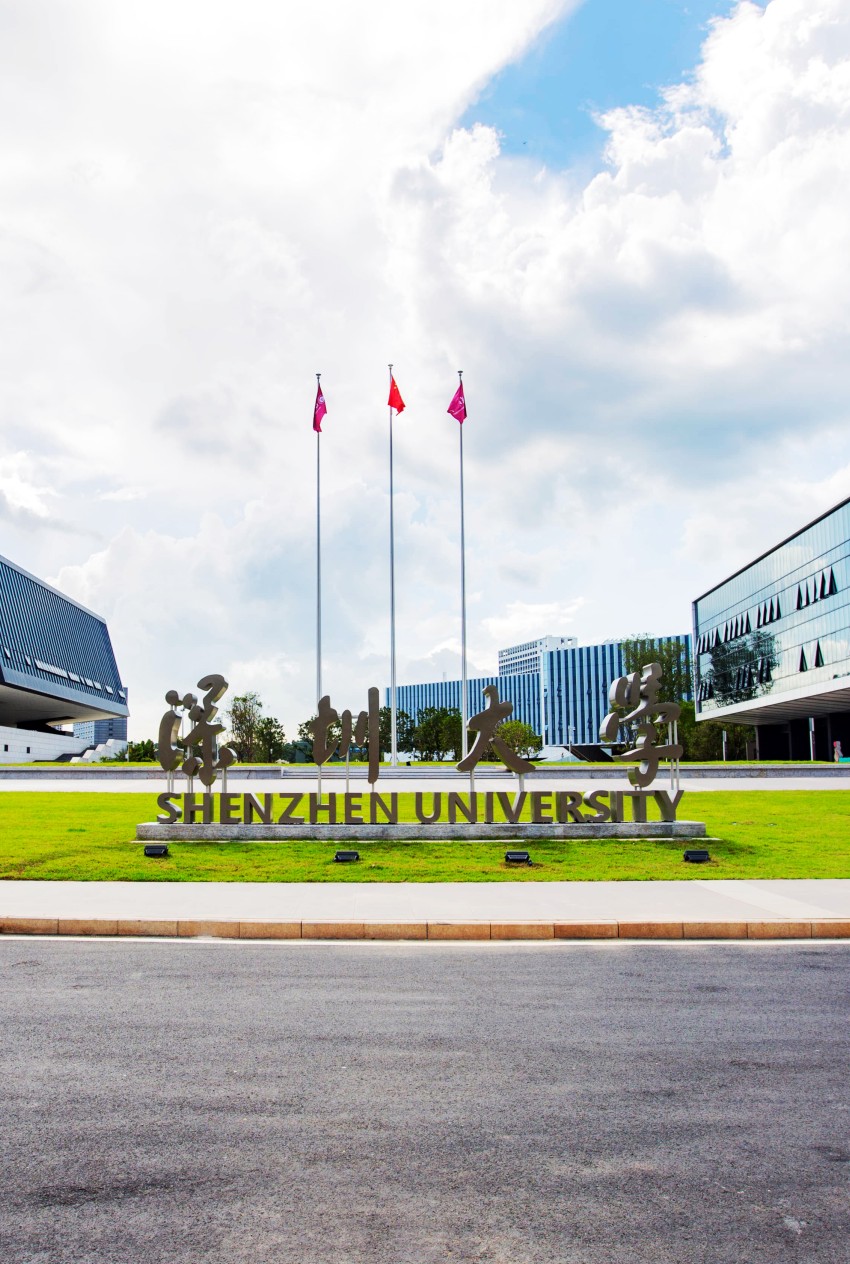Display technology serves as a vital bridge for information transmission and interaction, playing a pivotal role in advancing the digital economy. As an advanced next-generation display technology, organic light-emitting diodes (OLEDs) are shaping the future of the display industry owing to their outstanding color purity, ultra-high contrast ratio, and flexible form factor. Among the key driving forces behind high-definition OLEDs are high-performance organic electroluminescent materials. In recent years, multiple-resonance thermally activated delayed fluorescence (MR-TADF) materials, featuring rigid fused-ring frameworks and short-range charge transfer (SRCT) properties, have emerged as promising candidates for next-generation displays due to their high efficiency and narrowband emission. However, these materials still face critical challenges, including complex synthesis, long delayed fluorescence lifetimes, severe efficiency roll-off, and insufficient device operational stability, highlighting the need for innovative molecular design and device engineering strategies.
In the past two years, Professor Chuluo Yang and Assistant Professor Zhongyan Huang from the College of Materials Science and Engineering at Shenzhen University have carried out systematic studies on narrowband MR-TADF materials and devices. Their research has led to 11 high-impact publications in Nature Index journals, including Journal of the American Chemical Society, Advanced Materials, Angewandte Chemie International Edition, Advanced Functional Materials, and Chemical Science. Through the development of a series of innovative design concepts, they have made significant breakthroughs in the synthesis, excited-state regulation, and device performance of MR-TADF emitters.. The following is an overview of their key achievement:
1. Developed a novel synthetic method for boron-nitrogen multiple-resonance emitters. To address the challenge of synthesizing boron-nitrogen fused-ring materials, the team established a direct borylation approach guided by orienting groups, enabling the concise and efficient synthesis of such compounds. Mechanistic investigations elucidated the factors govering regioselectivity and clarified the relationship amone substrate structure, reaction conditions, and reaction yields. By employing this method, a series of narrowband boron-nitrogen compounds with emission wavelengths ranging from deep-blue to red were successfully synthesized. This work provides a powerful synthetic platform for the development of high-performance MR-TADF materials. Publication: L. Wu, Z. Huang*, J. Miao, S. Wang, X. Li*, N. Li, X. Cao, C. Yang*, Orienting group directed cascade borylation for efficient one-shot synthesis of 1,4-BN-doped polycyclic aromatic hydrocarbons as narrowband organic emitters, Angew. Chem. Int. Ed. 2024, 63, e202402020. (IF:16.9)
Publication link: https://onlinelibrary.wiley.com/doi/full/10.1002/anie.202402020
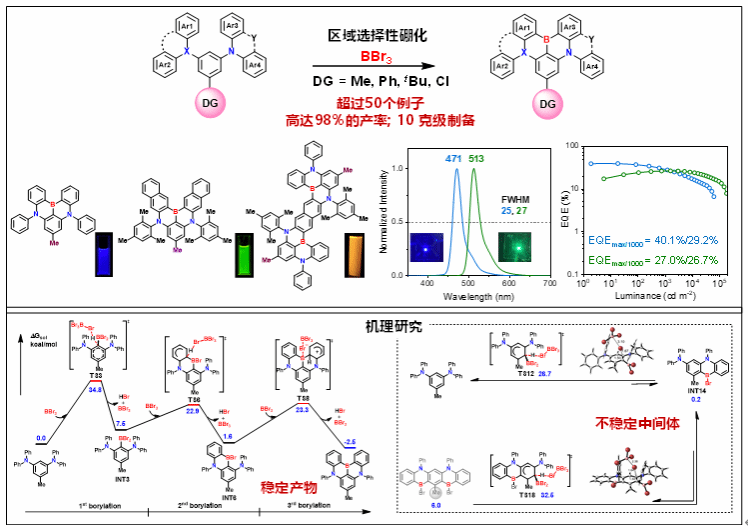
2. Enhanced the optoelectronic performance of MR-TADF materials through an “orthogonal donor” molecular design strategy. To overcome the challenges of a slow reverse intersystem crossing rate (kRISC) and severe efficiency roll-off in boron-nitrogen MR-TADF materials, the team proposed an orthogonal donor approach. This design maintains the short-range charge transfer (SRCT) characteristics of the lowest singlet excited state while introducing a long-range charge-transfer triplet state (³LRCT) through an orthogonally connected donor unit, thereby facilitating the reverse intersystem crossing (RISC) process. The designed molecule, CzBN3, exhibited a more than 20-fold enhancement in kRISC compared with the parent core BCzBN. The corresponding OLED demonstrated narrowband emission with a full-width at half maximum (FWHM) of only 27 nm, along with a high external quantum efficiency (EQE) of 42.3%, which was remained at 34.1% at 1000 cd m⁻². This work provides a universal molecular design strategy for developing high-performance MR-TADF materials. Publication: Z. Huang, H. Xie, J. Miao, Y. Wei, Y. Zou, T. Hua, X. Cao*, C. Yang*, Charge transfer excited state promoted multiple resonance delayed fluorescence emitter for high-performance narrowband electroluminescence, J. Am. Chem. Soc. 2023, 145, 23, 12550–12560.(IF:15.6,ESI Highly Cited Paper, Hot Paper)
Publication link: https://pubs.acs.org/doi/abs/10.1021/jacs.3c01267
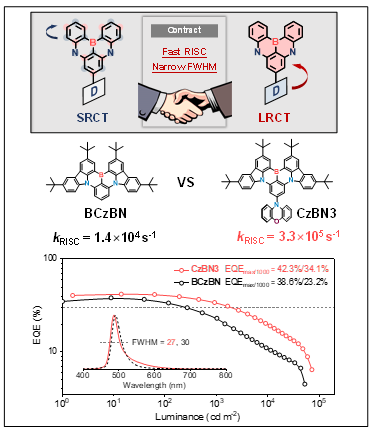
3. Enhanced the optoelectronic performance of MR-TADF materials through an “isomeric distortion” strategy. By systematically investigating the correlation between molecular structure and optoelectronic properties among isomers, the team revealed that core distortion effectively enhances spin-orbit coupling (SOC), shortens excited-state lifetimes, and increases intermolecular spacing, thereby suppressing aggregation-caused quenching (ACQ). The designed emitter, DPACz-2B, exhibited a high EQE of 32.7% with minimal efficiency roll-off, while maintaining a high EQE of 29.4% even at a doping concentration of 20 wt%. Publication: R. Ming, Z. Xue, Y. Xu, Z. Zhang, Z. Chen, J. Miao, Z. Huang*, C. Yang, Regioisomerization-directed MR-TADF emitters: Enhanced RISC and suppressed aggregation toward high-performance narrowband blue OLEDs, Angew. Chem. Int. Ed. 2025, e202516696. (IF:16.9,Hot Paper)
Publication link: https://onlinelibrary.wiley.com/doi/full/10.1002/anie.202516696
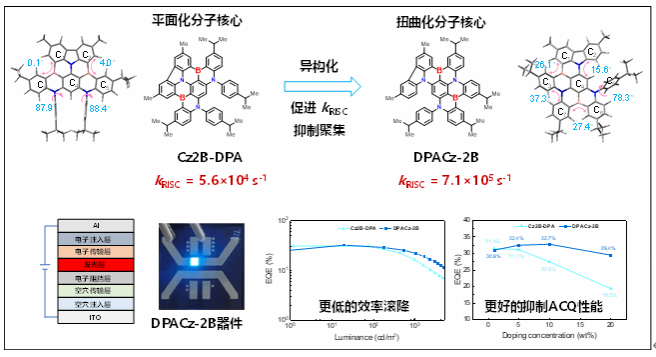
4. Synergistically enhanced the performance of green OLEDs through a combined “deuteration + sensitization” strategy. The team designed deuterated luminescent materials featuring high photoluminescence efficiency, high color purity, and improved chemical stability, while simultaneously introducing the commercially phosphorescent sensitizer Ir(ppy)₃ to construct sensitized OLEDs. The resulting pure green OLED exhibited a high EQE of 35.2%, with a CIEy value of 0.74, approaching the the BT.2020 green standard, and demonstrated an impressive operational lifetime (LT₅₀) exceeding 3000 hours. This work provides a promising strategy for advancing the practical application and commercialization of MR-TADF materials. Publication: J. Liu, X. Yin, M. Huang, J. Miao, N. Li, Z. Huang*, C. Yang*, High-performance narrowband pure-green OLEDs with gamut approaching BT.2020 standard: Deuteration promotes device efficiency and lifetime simultaneously, Adv. Mater. 2025, 37, 2411610. (IF:26.8)
Publication link: https://advanced.onlinelibrary.wiley.com/doi/10.1002/adma.202411610
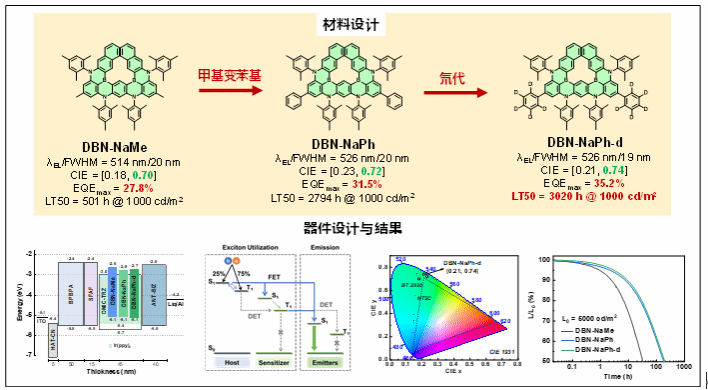
5. Proposed a synergistic “heavy-atom + aromaticity” strategy to enhance the optoelectronic performance of MR-TADF materials. In their earlier work, the team employed a heavy-atom effect strategy to improve the performance of MR-TADF materials, achieving pioneering results (Chem. Eng. J. 2021, 426, 131129. Cited 197 times, recognized as an ESI Highly Cited Paper; Nat. Photon. 2022, 16, 803. Cited 427 times, recognized as an ESI Highly Cited Paper and Hot Paper). However, due to the large atomic radii of heavy atoms such as sulfur and selenium, the designed molecules typically exhibited broadened emission spectra, limiting color purity and stability. In this work, the team embedded selenium atoms into an aromatic five-membered ring, effectively harnessing selenium’s heavy-atom effect to enhance the kRISC s, while simultaneously improving molecular stability through aromatic stabilization. The OLEDs based on DBSe-Ph achieved a high EQE of 38.8%, a narrow FWHM of only 24 nm, a CIEy value of 0.73, and excellent operational stability, thus overcoming long-standing challenges in color purity and durability for selenium-containing MR-TADF materials. Publication: J. Liu, J. Miao, J. Dong, Z. Chen, Z. Huang*, C. Yang*, Increasing aromaticity in selenium-embedded hetero ring enables stable narrowband multi-resonance TADF emitter for long-lifetime pure-green OLEDs, Adv. Mater. 2025, e13987. (IF:26.8)
Publication link: https://advanced.onlinelibrary.wiley.com/doi/10.1002/adma.202513987
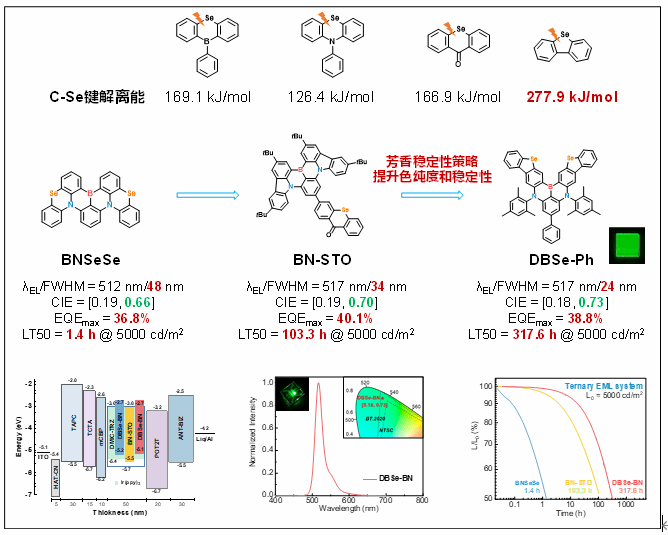
Project Support: This work was supported by the National Natural Science Foundation of China, the Guangdong Basic and Applied Basic Research Foundation, the Shenzhen Science and Technology Program, and the Scientific Foundation for Youth Scholars of Shenzhen University.
Managing Editor:Zhang Xiaoying
Reviser: Wang Dong, Wang Lei
